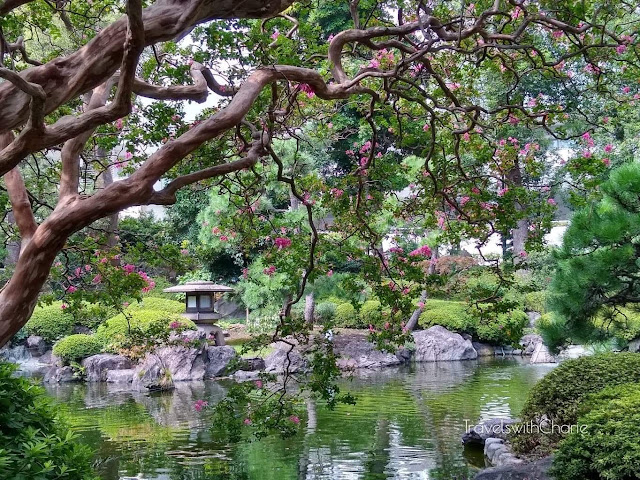On a recent unexpected layover in Tokyo, we were lucky to find a hotel in Shinagawa with a beautiful strolling garden. I would have missed it had I not caught a glimpse of greenery from the lobby after my morning walk. Since there was not much time before checkout, I skipped to the back door to discover this secret garden in the shadow of towering buildings. I wanted to learn more about Japanese gardens after this trip and found that there are several elements defining a Japanese garden.
- First of these are the trees and plants which are especially chosen to provide texture. Various types of shrubbery, grasses, moss, conifers and trees are carefully selected depending on the type of garden. There are no shade trees. Subtle use of color is achieved with flowering trees and shrubs like azaleas, camellias and hydrangeas. A stone pagoda lantern completes the picture.
- Water and carp. The Japanese garden is a refuge of calm especially for city dwellers weary of the daily grind and water has a therapeutic quality. The carp symbolizes strength and perseverance. It also adds color and movement to the garden.
- Stones and gravel. Stones represent the continuation of time and gravel mimics the flow of water. Both elements are important features of a dry or zen Japanese garden.
- Bridge. A bridge is essential to cross a pond and a place to stop and admire the colorful fishes below and the surrounding foliage.
This Japanese garden has a small temple which makes it all the more unique and special.
- Pavilion and lanterns. After a walk in the garden, a pavilion is a welcome respite where one can sit with a cup of tea and relax a moment before joining our hurried and harried world. Pavilions are often found in tea gardens. Lanterns are essential elements because they guide the way for nocturnal wanderers.
- Pagoda. The pagoda is the repository of relics and holy items of the Buddhist faith. In this Japanese garden, the pagoda is an architectural accessory. Each of its five roofs or levels represent earth, water, fire, wind and space.
How to get there:
The garden is easily accessed through the Grand Prince Takanawa Hotel in the hills above Shinagawa. It's a short walk from Shinagawa Station behind three of the Prince Hotels which are across the street from the Station.
*****
Images by TravelswithCharie





